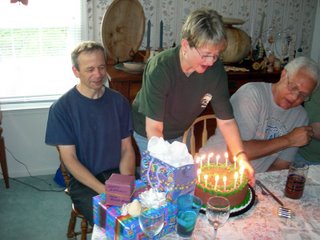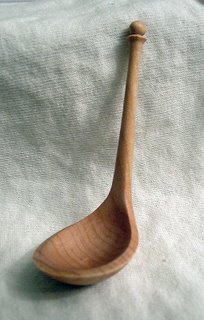 Friday was a day to try all the different techniques we had learned from the first four days of the class. Jean-François began by doing a demonstration of a simple two-axis box. This starts between centers and stays on the first axis until the final shaping of the lid.
Friday was a day to try all the different techniques we had learned from the first four days of the class. Jean-François began by doing a demonstration of a simple two-axis box. This starts between centers and stays on the first axis until the final shaping of the lid.The two tenons are made to fit into the Escoulen chuck. I don't think I mentioned before, but you wet the tenon before pushing it into the chuck using the tailstock as a lever.

The lid is parted off from the base section of the box.

The front face is trued.

Then the base is hollowed and a lip is made to seat the lid.

The base isn't finished at this point. The final shaping will be done after the lid has been hollowed. The lid is used as a jam chuck for the base and the two are shaped together prior to the finial being made.

A good fit is essential because the lid will become the jam chuck. Jean-François showed us how to size the tenon by testing the fit as you're going. This was always a mystery to me before this class - I haven't done more than a couple of boxes, but now I feel I have a better idea of how to do them after taking this class.

After the fit has been measured, the tenon is finished with a slight taper. The key word is "slight."

The lid is then hollowed. On a larger box, the hollowing would be done before the final fitting of the tenon to the base. That's because wood moves as the tension is released through hollowing. It's not a big deal on a small box, but can make a difference on a larger diameter one.

The base is then put onto the lid and the two are turned together to do the final shaping.

Jean-François uses the bedan tool to clean up the surface. I really enjoyed watching this master woodturner work at the lathe. I think he has an advantage in being left handed for the spindle work we did all week. He can work toward the headstock much more comfortably than us right handed turners.

That's a nicely fitted lid, don't you agree?

A few detail features on the base after it's been cleaned up. This is a custom ground tool - basically a diamond point scraper with a second indentation to the right of the point. There's another shot of it below. It's a good tool to use for etching clean lines into a surface.

The base is now finished.

With the Escoulen chuck you can also do some interesting surface enhancements by putting the box off center and cutting a line into only a small part of the surface. Rotate the box one index point and do the same, except just above or below the original line. You have some interesting lines around the box - kind of like ornamental turning without the mechanical setup of an ornamental lathe.

The lid is then turned on the second axis - just like making the golf club shape. I forgot to get a picture of the final box, but you can imagine what this finial looks like.
Friday of the class was also Bastille Day so we decided it would be a good idea to have a lunchtime party to celebrate. Barbara Crockett has hosted us in her shop all week, and she knew that Jean-François had never had an American-style birthday celebration, so we decided that Bastille Day was a good excuse to throw a surprise belated/early birthday party.

Here's Barbara delivering the cake (not enough candles!). That's Booker Brooks trying to get out of the way on the right. Jean-François is looking puzzled. We're all singing "Happy Birthday" to him.

He was a good sport and blew out the candles, only the candles didn't cooperate all that well. They were those trick candles that only go out if you drown them in water.

It's a "thing." Huh?

What is it?
Jean-François kept borrowing pencils and sharpeners all week and then pocketing them as he walked away. He received a set of pencils and a sharpener (as show here).

Ok, so this is pretty fun. Not Bastille Day, but an acceptable substitute.

A couple of more pics to end the week. This was a platter Scott Hogsten was working on with Escoulen's new faceplate eccentric chuck.

Here are some of my hollowing exercises.

I also decided to tackle the double box, which was really a lot of fun to do. It does take some nerve to get inside to hollow the lower box. The upper box is swinging around like a club as you're moving the hollowing tools inside the shadow tube that forms.

Here's what it looks like before the base and lids are made.

Silly as it seems, my favorite project of this week was this simple spoon. I made it for my small sugar bowl - the only project I actually made to completion and intend to use.
I had such a good time all week! Jean-François is a delightful teacher who has a good sense of humor and who is a master woodturner all rolled into one package.











No comments:
Post a Comment